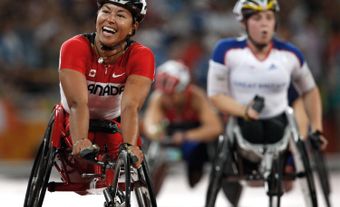Disability culture is the shared community knowledge, traditions and art of the disability community. To be connected to disability culture means understanding that disabled people have a long history of approaching the world through community. Disability culture is heavily influenced and connected to the world of disability art.
The term disability culture has increasingly been used since the mid-1990s. However, it does not have the lengthy formal history of deaf culture. While there are crossovers, deaf communities have a different view of the world compared to disability culture. Disability culture in Canada is especially present in larger cities like Toronto and Vancouver. However, it’s also being brought forward elsewhere in the country.
Editorial note: This article and its author recognize that both person-first language (person with a disability) and identity-first language (disabled person) are used within the Canadian disability community. As a result, both are used throughout the article.
History of Disability Culture
The origins of the phrase disability culture are contested. The term is deeply connected to the disability rights and independent living movements of the 1960s and 1970s. (See Disability Rights Movement in Canada.) One of the most cited creators of a worldwide definition is Steven E. Brown. In 1996, he wrote that disability culture is “infused from our experience of disability.” Most definitions of disability culture focus on disability pride, disability art and ableism. Some also focus on the intersection between disability and other marginalized community cultures. (See also Queer Culture; Intersectionality). There is a deep link between disabled self-determination and disability culture. Disability culture is about disabled people being able to create their own future paths. It also means keeping disability a foundation of their identity.
It’s important to note that there is no singular disability culture. Disability is not a monolith. Instead, these are basic ideas built on group oppression and liberation. For example, disability culture in Saskatchewan may be radically different from the one in Ottawa; however, their core building blocks will be similar. Conversely, the cultural experience of racialized disabled people is often radically different from those of others. This is in large part due to disability activist circles being historically predominantly white. Disability culture is also inherently tied to the concept of disability justice. For some advocates, existence is a form of resistance.
Symbols of Disability Culture and Disability Pride
One symbol of disability culture and disability pride is the disability pride flag. Ann Magill created it in 2019. It’s meant to represent the varied experiences of disabled people. It also presents the literal dark backdrop of harm that comes with living with disabilities in an ableist world. These are the types of experiences that are commemorated during events like the Autistic Self Advocacy Network-led Disability Day of Mourning. There is also a disability flag, created in 2017 for the United Nations. Other symbols include the rainbow infinity symbol popular in the autistic community. (See Autism Spectrum Disorder (ASD) in Canada.)
In North America, disability pride month is held each July. It coincides with the anniversary of the Americans with Disabilities Act. The United Nations International Day of Persons with Disabilities is held each December 3. It’s another key date in disability circles when discussing disability pride. In the past, disability-focused events have also been held with Culture Days, a Canada-wide festival focused on celebrating culture. Those events are often supported by various provincial cultural organizations. Projects that track the history of disability art, like the UK’s Disability Arts International, provide context for disability art production in Canada, with activities happening across Canada.
While there is no consensus on whether paralympic sport is a part of disability culture, paralympic sports do have a tangible impact (both positive and negative) on the general public’s perception of disabled people in Canada. Some in disability cultural circles are especially frustrated with the perception that all disabled people should want to participate in sport. It’s a divide that mirrors the common tensions between artists and athletes.
Future of Disability Culture
Universities across Canada study disability culture through disability studies programs. The COVID-19 pandemic has also shone a light on disability culture. It showed how ideas tied to disability and built on access can help us understand how the world is reshaped during a mass-disabling pandemic.
American activists like Andrew Pulrang argue that disability culture is shifting as generations of disabled people interact with each other. They state that the future of disability culture is in flux as multiple generations of disability leaders emerge. Previously, the narrative focused on one (largely) agreed-upon trajectory for the disability rights movement, often cited as being the independent living movement of the 1960s and 1970s. The independent living movement was focused on moving disabled people from institutions and towards living in the wider community. Today, disability culture has become the product of a collection of disabled community experiences rather than a singular vision. Members have diverse access needs and wants that are increasingly visible as conversations continue. Disability activists are also intermingling with other activist circles, such as anti-racism (see also Anti-Racism Education in Canada) and environmental movements (see Environmental Movement in Canada).
Disability culture is becoming more prolific within the disability community beyond just academic or politically active circles. While disability culture does not have as long of a formal history as other marginalized communities’ cultures, it does provide a vital way for disabled people to contextualize their own experiences. To become disabled, for most people, is an inevitability. Disability culture allows us to understand how to enter into disabled life with more support and self-compassion.

 Share on Facebook
Share on Facebook Share on X
Share on X Share by Email
Share by Email Share on Google Classroom
Share on Google Classroom

